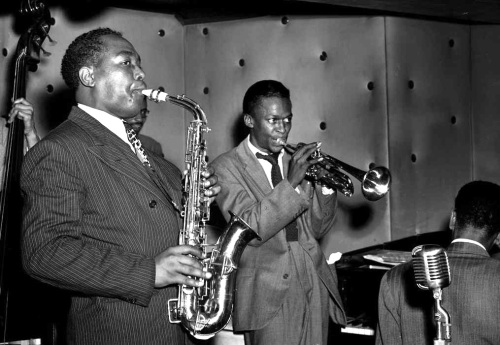
One of Benny Golson’s earliest memories as a child was being taken to Minton’s Playhouse in Harlem, a now-legendary site of the earliest bop jam sessions, and seeing the house band play with Thelonious Monk, Joe Guy and Kenny Clarke. “I was 11 and didn’t know what the heck it was all about,” he admitted. “But Sugar Ray Robinson was there and my uncle [a bartender at the Playhouse] introduced me to him.” From 1947 to 1950, Golson studied music at Howard University in Washington, D.C., where he began composing and arranging music while playing in a big band. There, he met pianist and composer Tadd Dameron, whose style of composition and arrangement he admired. In 1953, briefly performing with Clifford Brown in Dameron’s band, Golson joined Lionel Hampton’s orchestra, where he met future collaborators Art Farmer and Quincy Jones.
From 1954 to 1956, he played in Earl Bostic’s band while also gaining recognition as a composer. One of his early compositions, Stablemates, was performed by the legendary Miles Davis Quintet (featuring John Coltrane, whom Golson knew as a boy while growing up in Philadelphia) in 1955 and recorded on The New Miles Davis Quintet album. Golson then joined Dizzy Gillespie’s orchestra in 1956, where he worked as both a composer and arranger. He toured South America with the band, which disbanded in early 1958. Golson was then invited by Art Blakey to become the tenor saxophone soloist and musical director of the Jazz Messengers. During his tenure with the band, he composed iconic pieces such as I remember Clifford, Whisper not, Blues march, and Along came Betty, helping propel the ensemble to prominence within the hard bop movement. Golson himself regarded his time with Blakey’s Jazz Messengers as the peak of his compositional achievements.

In 1959 he studied composition with Henry Brandt and founded the Jazztet together with trumpeter Art Farmer, which initially existed until 1962. For this ensemble, Golson composed and arranged a three-part wind section, including the hit song Killer Joe. The years 1956 to 1962 were the high point in Golson’s jazz career, and in 1963 he stopped playing music for several years. After further studies with Brandt, who also worked as a film composer, Golson received composition commissions in Europe, where he worked mainly from 1964 to 1966.
After moving to Hollywood in 1967, Golson wrote music for numerous films and television shows such as Mission: Impossible and M*A*S*H. From 1975 onwards, he was sporadically active as a tenor saxophonist, but only ambitiously from 1982, the year the Jazztet was re-founded with Farmer. The ensemble, which was again very successful, performed in Japan and Europe in 1982 and undertook a tour of Southeast Asia in 1987, where Golson was commissioned to compose music for the Bangkok Symphony Orchestra. His work Two faces for symphony orchestra was premiered in New York in 1992. In 1994, Golson won the Guggenheim Fellowship for Composers. He has also worked as a lecturer at several universities and colleges since the 1980s.

Golson’s playing has been characterized by a warm tone and melodious lines. Discussing his composition style in a 2009 interview with Downbeat, Golson said “What gives a composition validity is the knowledge of the person writing it, the experience he can draw on. But when you get to the meat of it, it’s in the intervals, what follows what. That’s what a melody is. When I write my songs, I’m conscious of intervals . . . You get the right intervals in place and you’ve got something that will live past your time.”
Golson was inducted into the Jazz Hall of Fame in 2009 and received the Grammy Trustees Award in 2021. His autobiography Whisper not was published in 2016. Benny Golson passed away in New York City on 21 September 2024 at the age of 95.
Read the full entry on Benny Golson, along with his obituary in MGG Online.





